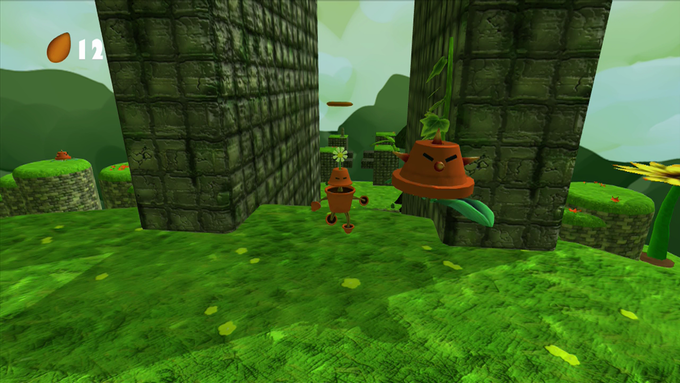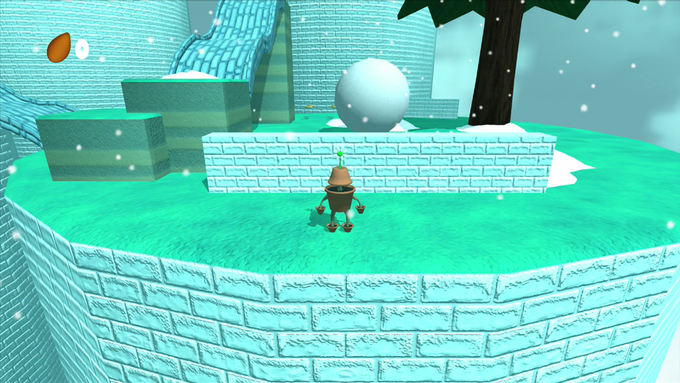PitterPot is the latest 3D Platformer to grace Kickstarter, and normally I’d gush over that fact for a few hundred words. Not today though. Glancing at its Kickstarter page shows how rough PitterPot currently is. Judging by the lack of funding and attention it’s received since it’s launch, things aren’t looking good for developer TreeFall Studios. As the dominatrix watched her client being wheeled into the ambulance, potential backers must ask themselves the same question of themselves as she, how rough is too rough?
PitterPot is probably too rough to ask $8,000 for. The levels are flat, lacking much in the way of detail and variety. There doesn’t seem to be much of the gameplay structure in place outside walking and jumping. And the character models. The character models, including the player character and enemies, are literally just flower pots with black lines on the front, presumably representing eyes.
The entire conceit of crowdfunding is that a creator pitches their unfinished creation to an audience in the hopes of receiving funding to finish it. As a result, the creation being pitched doesn’t always have the benefit of its potential final production. You may be surprised at how unpolished some of the earliest Kickstarter campaigns look compared to today’s high standards.
That’s the issue though, as crowdfunding became popular, particularly Kickstarter, bigger studios with more time and money were able to use those resources to make higher caliber pitches than those without. The studios that perhaps only need money to finish their game receive more than those who need funding to even get their idea off the ground.
 Take 3D platformers for instance. They have an appalling record when it comes to crowdfunding. Their appearances on Kickstarter are as rare a sight as an Xbox One exclusive, and their success rate is on par with the number of Xbox One games that have been canceled. It seems as though PitterPot’s Kickstarter campaign was dead before it even began, even with its minuscule $8,000 funding goal.
Take 3D platformers for instance. They have an appalling record when it comes to crowdfunding. Their appearances on Kickstarter are as rare a sight as an Xbox One exclusive, and their success rate is on par with the number of Xbox One games that have been canceled. It seems as though PitterPot’s Kickstarter campaign was dead before it even began, even with its minuscule $8,000 funding goal.
Kickstarter has become the ultimate catch-22. A campaign has to be declared unfit for duty to get out of flying a dangerous mission over Italy, but the army has made that impossible. Conversely, the crew of the 256th Squadron need money to make their fundraising pitch look good enough to compete with the bigger campaigns, but they have no money. Do they risk spending all their resources on making the campaign look as good as possible, or do they use those resources to bomb Nazi positions in Bologna and hope for the best?
None of this is to say that the bemoaned “big indies” are the problem, it’s often these big companies and sometimes even vanity projects that inject new blood into the crowdfunding scene. It’s hard to say that this situation is a problem at all and not just an unfortunate fact of life for crowdfunding. Smaller studios outside of crowdfunding have always had a hard time getting recognition thanks to the massive marketing budgets of AAA games.
 I’ve often heard solutions that call for adding a second category for smaller studios, the idea being that having two sections for the “big indies” and the “small indies” will somehow give everyone an equal platform. In reality, it’d only further malign small studios. Crowdfunding platformers are already incentivized to drive traffic to bigger campaigns for the sake of profit. Further splitting them up would only make it easier for them. How would studios even be divided between big and small anyway? That’s not even to mention the obvious segregation tones that would arise.
I’ve often heard solutions that call for adding a second category for smaller studios, the idea being that having two sections for the “big indies” and the “small indies” will somehow give everyone an equal platform. In reality, it’d only further malign small studios. Crowdfunding platformers are already incentivized to drive traffic to bigger campaigns for the sake of profit. Further splitting them up would only make it easier for them. How would studios even be divided between big and small anyway? That’s not even to mention the obvious segregation tones that would arise.
So what is the solution? As is so often the case, there isn’t one, universal truth that will set us free. Just like it’s down to the individual developer whether they want to crowdfund or not, they must also decide the right time to unveil their game.
PitterPot is in an unquestionably rough state, tempting you to think TreeFall launched the campaign too early. Everyone gets one first impression, and a bad one can do irreversible damage. But we don’t know what’s going on behind the scenes. This campaign could be an act of necessity for both the game and the developer. On the other hand, this or any developer who releases a rough looking campaign, can’t be a case of “this developer is struggling so let’s help them,” because we don’t know if they’re not very good at their job, that they’re capable of using the money wisely to finish the game, or because it just might be a scam. These are the pitfalls of crowdfunding.
 Once again we come to the conclusion that crowdfunding opens up a whole can of worms. It’s full of pitfalls for both developers and backers. It’s not a guaranteed blank check for creators, and it’s not a preorder service for gamers. PitterPot could be a great game one day, but due to an unfortunate case of circumstance, it may never get that chance. It’s a shame, but it’s also a fact of life.
Once again we come to the conclusion that crowdfunding opens up a whole can of worms. It’s full of pitfalls for both developers and backers. It’s not a guaranteed blank check for creators, and it’s not a preorder service for gamers. PitterPot could be a great game one day, but due to an unfortunate case of circumstance, it may never get that chance. It’s a shame, but it’s also a fact of life.
Hopefully TreeFall will read that last line and turn into any movie/TV show/video game protagonist and set out on an epic journey to prove me wrong. We need more 3D platformers, damn it!




First off, your analogy game is on point. There’s a lot here, and they’re all perfect. Bravo 🙂
Secondly, props to getting through this whole article without ever mentioning Treefall is the studio responsible for the infamous “The Letter”. Which was popular on Youtube for awhile a few years ago as “The Worst Game Ever” and “The Worst Game on the Wii U”, etc. Harsh and hyperbolic maybe, but the point is made – the name isn’t exactly associated with quality.
Put simply, the guy behind these games is not a great developer. Seems self-taught, and definitely shows improvement from game-to-game… but its like, an amount of improvement on par with the leap in quality from Blast Corps to Jet Force Gemini. Its a much nicer looking and playing N64 game with much more ambition, but its still ultimately an N64 game… in 2017. This guy is far too behind to be where he wants to be (hopefully he doesn’t think he’s able to actually compete).
The game’s obviously going to be rough, because it seems to be built wrong – art first, instead of getting underlying game mechanics polished and refined in simply-textured test rooms (although the areas shown are made of such simple geometry that they could certainly pass for “grey box” test rooms if they had their textures removed), and then building the game after – crafting it around what abilities are working and feel good – it just seems to all be haphazardly made at the same time. Which, hey, at least there are game mechanics now – as basic as they are, it is an improvement from prior Treefall productions, “The Letter” and “The Maze”.
Still though, there’s tons of people who can – and do – fart out better productions onto Steam without asking for development money. Whoever makes those Woodle Tree games, for instance. When something like Griff: The Winged Lion bombs its Kickstarter, this thing has no chance.